Power Citroen GRAND C4 PICASSO 2017 2.G User Guide
[x] Cancel search | Manufacturer: CITROEN, Model Year: 2017, Model line: GRAND C4 PICASSO, Model: Citroen GRAND C4 PICASSO 2017 2.GPages: 527, PDF Size: 12.91 MB
Page 149 of 527
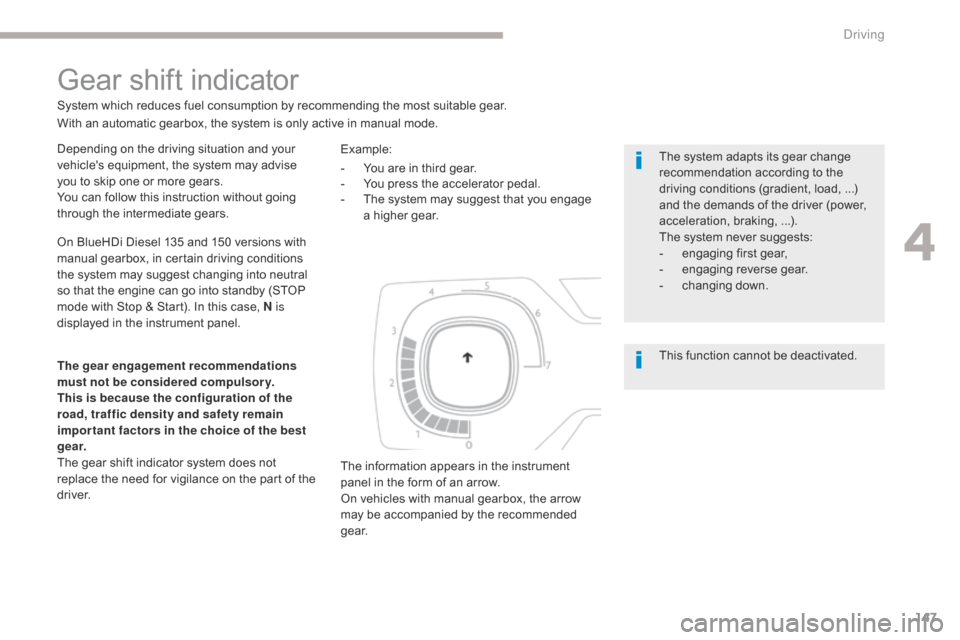
147
C4-Picasso-II_en_Chap04_conduite_ed02-2016
Depending on the driving situation and your
vehicle's equipment, the system may advise
you to skip one or more gears.
You can follow this instruction without going
through the intermediate gears.
Gear shift indicator
System which reduces fuel consumption by recommending the most suitable gear.The system adapts its gear change
recommendation according to the
driving conditions (gradient, load,
...)
and the demands of the driver (power,
acceleration, braking,
...).
The system never suggests:
-
e
ngaging first gear,
-
enga
ging reverse gear.
-
c
hanging down.
The information appears in the instrument
panel in the form of an arrow.
On vehicles with manual gearbox, the arrow
may be accompanied by the recommended
g e a r.
The gear engagement recommendations
must not be considered compulsory.
This is because the configuration of the
road, traffic density and safety remain
impor tant factors in the choice of the best
g e a r.
The gear shift indicator system does not
replace the need for vigilance on the part of the
driver. With an automatic gearbox, the system is only active in manual mode.
On BlueHDi Diesel 135 and 150 versions with
manual gearbox, in certain driving conditions
the system may suggest changing into neutral
so that the engine can go into standby (STOP
mode with Stop & Start). In this case, N is
displayed in the instrument panel. Example:
This function cannot be deactivated.
-
Y
ou are in third gear.
-
Y
ou press the accelerator pedal.
-
T
he system may suggest that you engage
a higher gear.
4
Driving
Page 150 of 527
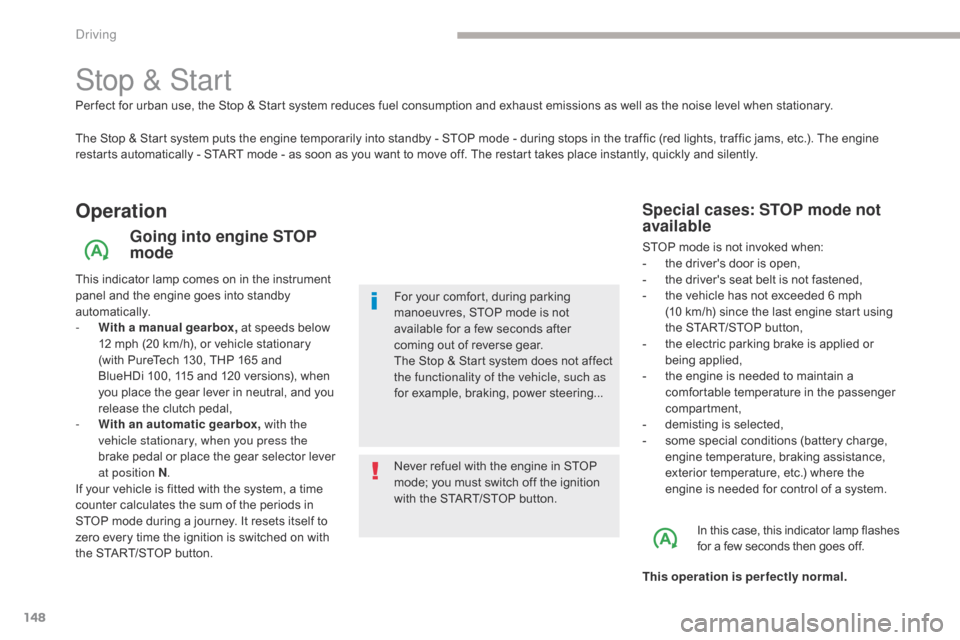
148
C4-Picasso-II_en_Chap04_conduite_ed02-2016
Stop & Start
The Stop & Start system puts the engine temporarily into standby - STOP mode - during stops in the traffic (red lights, traffic jams, etc.). The engine
restarts automatically - START mode - as soon as you want to move off. The restart takes place instantly, quickly and silently.
Operation
Going into engine STOP
mode
This indicator lamp comes on in the instrument
panel and the engine goes into standby
automatically.
-
W
ith a manual gearbox, at speeds below
12 mph (20 km/h), or vehicle stationary
(with PureTech 130, THP 165 and
BlueHDi
100, 115 and 120 versions), when
you place the gear lever in neutral, and you
release the clutch pedal,
-
Wi
th an automatic gearbox, with the
vehicle stationary, when you press the
brake pedal or place the gear selector lever
at position N .
If your vehicle is fitted with the system, a time
counter calculates the sum of the periods in
STOP mode during a journey. It resets itself to
zero every time the ignition is switched on with
the START/STOP button. Never refuel with the engine in STOP
mode; you must switch off the ignition
with the START/STOP button. For your comfort, during parking
manoeuvres, STOP mode is not
available for a few seconds after
coming out of reverse gear.
The Stop & Start system does not affect
the functionality of the vehicle, such as
for example, braking, power steering...
Special cases: STOP mode not
available
STOP mode is not invoked when:
-
t he driver's door is open,
-
t
he driver's seat belt is not fastened,
-
t
he vehicle has not exceeded 6 mph
(10
km/h) since the last engine start using
the START/STOP button,
-
t
he electric parking brake is applied or
being applied,
-
t
he engine is needed to maintain a
comfortable temperature in the passenger
compartment,
-
d
emisting is selected,
-
s
ome special conditions (battery charge,
engine temperature, braking assistance,
exterior temperature, etc.) where the
engine is needed for control of a system.
In this case, this indicator lamp flashes
for a few seconds then goes off.
This operation is perfectly normal.
Per fect for urban use, the Stop & Start system reduces fuel consumption and exhaust emissions as well as the noise level when stationary.
Driving
Page 199 of 527
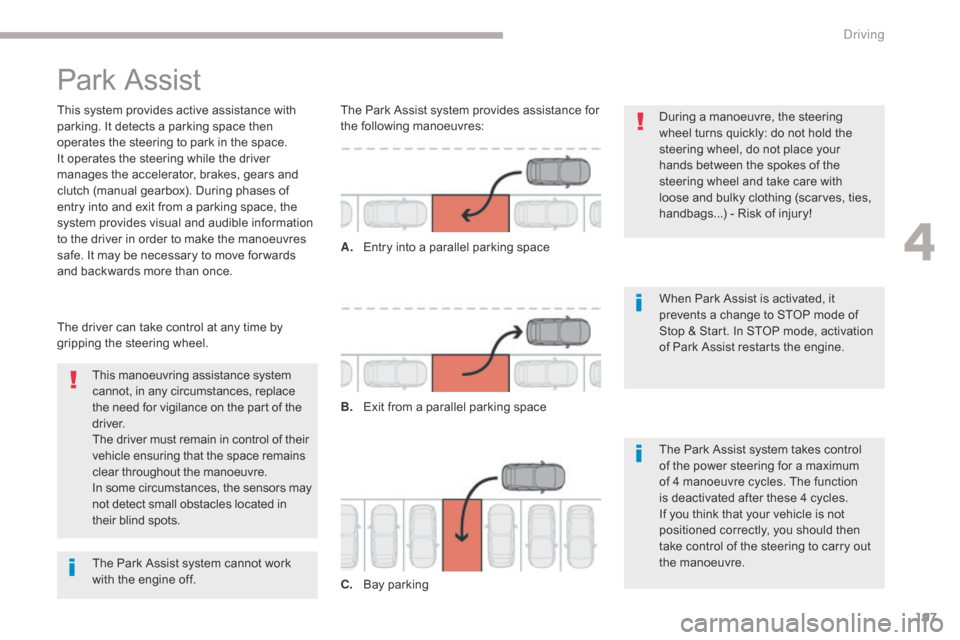
197
C4-Picasso-II_en_Chap04_conduite_ed02-2016
Park Assist
This system provides active assistance with
parking. It detects a parking space then
operates the steering to park in the space.
It operates the steering while the driver
manages the accelerator, brakes, gears and
clutch (manual gearbox). During phases of
entry into and exit from a parking space, the
system provides visual and audible information
to the driver in order to make the manoeuvres
safe. It may be necessary to move for wards
and backwards more than once.During a manoeuvre, the steering
wheel turns quickly: do not hold the
steering wheel, do not place your
hands between the spokes of the
steering wheel and take care with
loose and bulky clothing (scarves, ties,
handbags...) - Risk of injury!
When Park Assist is activated, it
prevents a change to STOP mode of
Stop & Start. In STOP mode, activation
of Park Assist restarts the engine.
This manoeuvring assistance system
cannot, in any circumstances, replace
the need for vigilance on the part of the
driver.
The driver must remain in control of their
vehicle ensuring that the space remains
clear throughout the manoeuvre.
In some circumstances, the sensors may
not detect small obstacles located in
their blind spots.
The driver can take control at any time by
gripping the steering wheel. The Park Assist system provides assistance for
the following manoeuvres:
A.
E
ntry into a parallel parking space
B.
E
xit from a parallel parking space
C.
B
ay parkingThe Park Assist system takes control
of the power steering for a maximum
of 4 manoeuvre cycles. The function
is deactivated after these 4 cycles.
If you think that your vehicle is not
positioned correctly, you should then
take control of the steering to carry out
the manoeuvre.
The Park Assist system cannot work
with the engine off.
4
Driving
Page 206 of 527
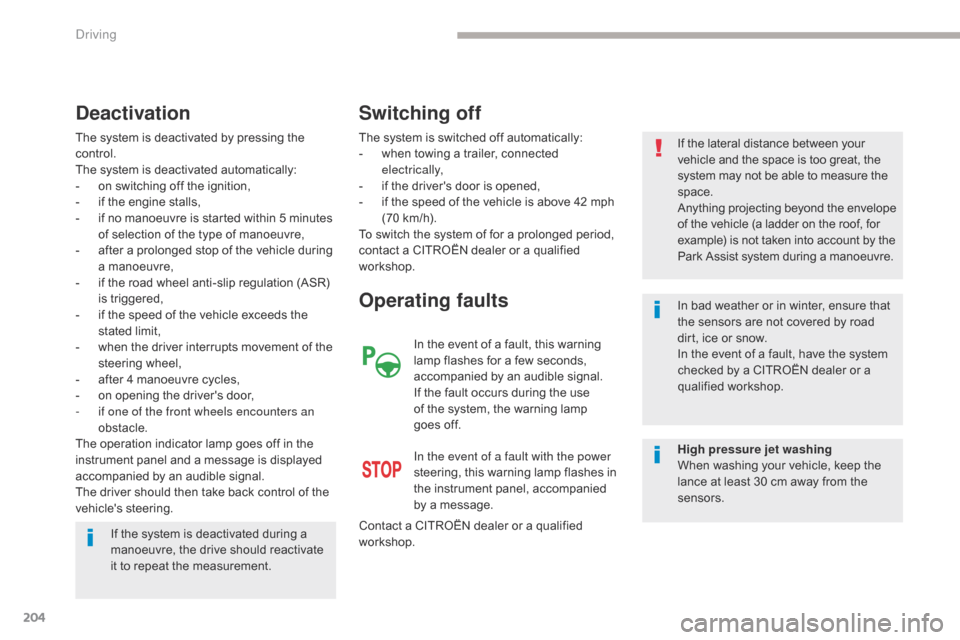
204
C4-Picasso-II_en_Chap04_conduite_ed02-2016
The system is deactivated by pressing the
control.
The system is deactivated automatically:
-
o
n switching off the ignition,
-
i
f the engine stalls,
-
i
f no manoeuvre is started within 5 minutes
of selection of the type of manoeuvre,
-
a
fter a prolonged stop of the vehicle during
a manoeuvre,
-
i
f the road wheel anti-slip regulation (ASR)
is triggered,
-
i
f the speed of the vehicle exceeds the
stated limit,
-
w
hen the driver interrupts movement of the
steering wheel,
-
a
fter 4 manoeuvre cycles,
-
o
n opening the driver's door,
-
i
f one of the front wheels encounters an
obstacle.
The operation indicator lamp goes off in the
instrument panel and a message is displayed
accompanied by an audible signal.
The driver should then take back control of the
vehicle's steering.
Deactivation
The system is switched off automatically:
- w hen towing a trailer, connected
electrically,
-
i
f the driver's door is opened,
-
i
f the speed of the vehicle is above 42 mph
(70 km/h).
To switch the system of for a prolonged period,
contact a CITROËN dealer or a qualified
workshop.
Operating faults
In the event of a fault with the power
steering, this warning lamp flashes in
the instrument panel, accompanied
by a message.
Contact a CITROËN dealer or a qualified
workshop.
Switching off
If the lateral distance between your
vehicle and the space is too great, the
system may not be able to measure the
space.
Anything projecting beyond the envelope
of the vehicle (a ladder on the roof, for
example) is not taken into account by the
Park Assist system during a manoeuvre.
In bad weather or in winter, ensure that
the sensors are not covered by road
dirt, ice or snow.
In the event of a fault, have the system
checked by a CITROËN dealer or a
qualified workshop.
If the system is deactivated during a
manoeuvre, the drive should reactivate
it to repeat the measurement. In the event of a fault, this warning
lamp flashes for a few seconds,
accompanied by an audible signal.
If the fault occurs during the use
of the system, the warning lamp
goes
off. High pressure jet washing
When washing your vehicle, keep the
lance at least 30 cm away from the
sensors.
Driving
Page 216 of 527
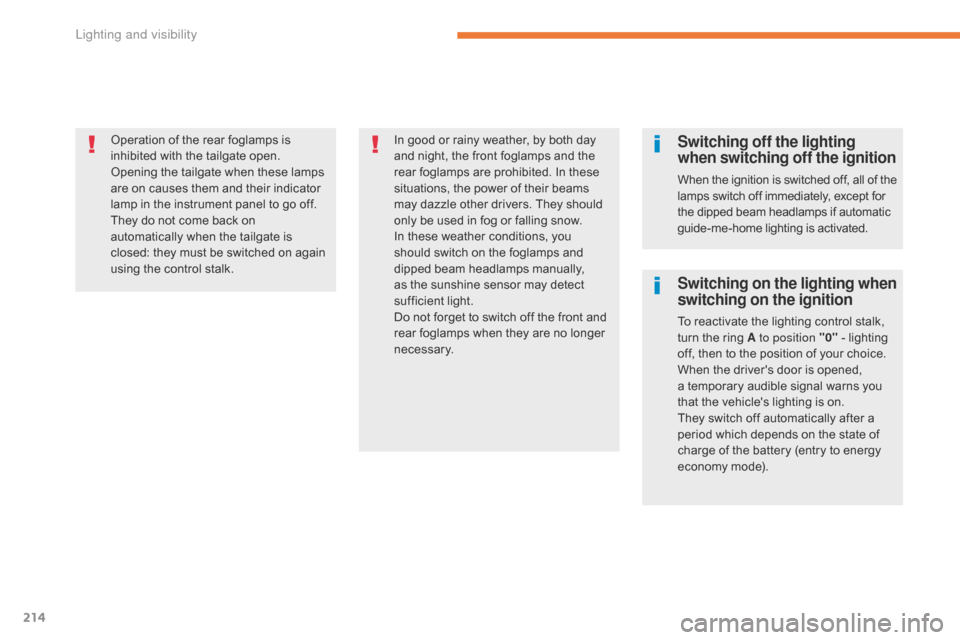
214
C4-Picasso-II_en_Chap05_eclairage-visibilite_ed02-2016
Operation of the rear foglamps is
inhibited with the tailgate open.
Opening the tailgate when these lamps
are on causes them and their indicator
lamp in the instrument panel to go off.
They do not come back on
automatically when the tailgate is
closed: they must be switched on again
using the control stalk.In good or rainy weather, by both day
and night, the front foglamps and the
rear foglamps are prohibited. In these
situations, the power of their beams
may dazzle other drivers. They should
only be used in fog or falling snow.
In these weather conditions, you
should switch on the foglamps and
dipped beam headlamps manually,
as the sunshine sensor may detect
sufficient
light.
Do not forget to switch off the front and
rear foglamps when they are no longer
necessary.Switching off the lighting
when switching off the ignition
When the ignition is switched off, all of the
lamps switch off immediately, except for
the dipped beam headlamps if automatic
guide-me-home lighting is activated.
Switching on the lighting when
switching on the ignition
To reactivate the lighting control stalk,
turn the ring A to position "0" - lighting
off, then to the position of your choice.
When the driver's door is opened,
a
temporary audible signal warns you
that the vehicle's lighting is on.
They switch off automatically after a
period which depends on the state of
charge of the battery (entry to energy
economy mode).
Lighting and visibility
Page 229 of 527
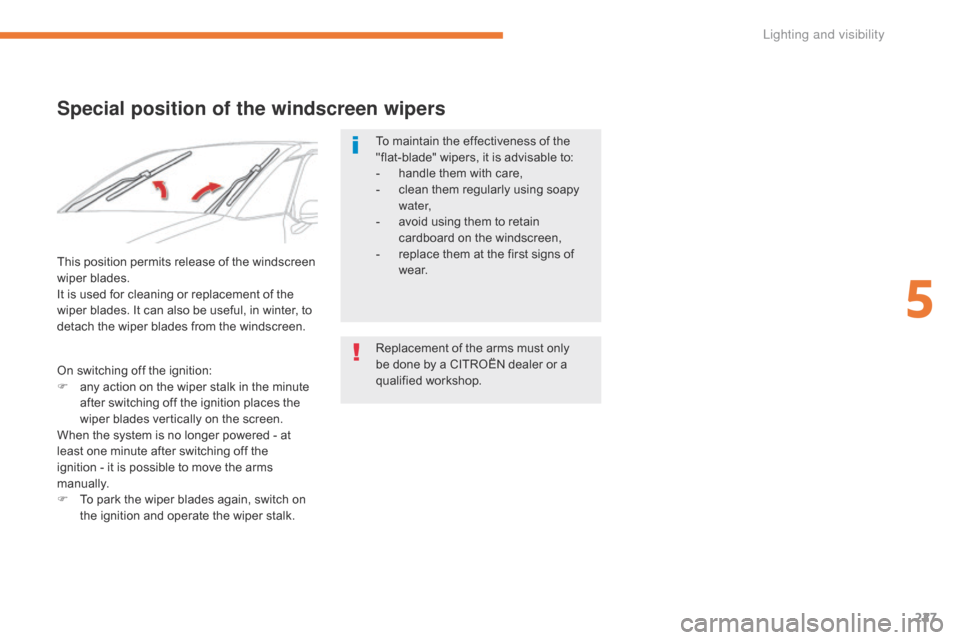
227
C4-Picasso-II_en_Chap05_eclairage-visibilite_ed02-2016
Special position of the windscreen wipers
To maintain the effectiveness of the
"flat-blade" wipers, it is advisable to:
-
h
andle them with care,
-
c
lean them regularly using soapy
water,
-
a
void using them to retain
cardboard on the windscreen,
-
r
eplace them at the first signs of
w e a r.
This position permits release of the windscreen
wiper blades.
It is used for cleaning or replacement of the
wiper blades. It can also be useful, in winter, to
detach the wiper blades from the windscreen.
On switching off the ignition:
F
a
ny action on the wiper stalk in the minute
after switching off the ignition places the
wiper blades vertically on the screen.
When the system is no longer powered - at
least one minute after switching off the
ignition
- it is possible to move the arms
manually.
F
T
o park the wiper blades again, switch on
the ignition and operate the wiper stalk. Replacement of the arms must only
be done by a CITROËN dealer or a
qualified workshop.
5
Lighting and visibility
Page 231 of 527

229
C4-Picasso-II_en_Chap06_securite_ed02-2016
General safety recommendations
Labels are applied at various
points on your vehicle. They carry
safety warnings as well as vehicle
identification information. Do not
remove them: they form an integral part
of your vehicle.
For any work on your vehicle, use
a qualified workshop that has the
technical information, skills and
equipment required, all of which a
CITROËN dealer is able to provide.We draw your attention to the following points:
- The fitting of electrical equipment or accessories not listed by CITROËN may cause
excessive current consumption and faults and failures with the electrical system of
your vehicle. Contact a CITROËN dealer for information on the range of recommended
accessories.
-
A
s a safety measure, access to the diagnostic socket, used for the vehicle's electronic
systems, is reserved strictly for CITROËN dealers or qualified workshops, equipped
with the special tools required (risk of malfunctions of the vehicle's electronic systems
that could cause breakdowns or serious accidents). The manufacturer cannot be held
responsible if this advice is not followed.
-
A
ny modification or adaptation not intended or authorised by Automobiles CITROËN
or carried out without meeting the technical requirements defined by the manufacturer
would lead to the suspension of the legal and contractual warranties.
Installation of accessory radio communication transmitters
Before installing a radio communication transmitter, you must contact a CITROËN dealer
for the specification of transmitters which can be fitted (frequency, maximum power,
aerial position, specific installation requirements), in line with the Vehicle Electromagnetic
Compatibility Directive (2004/104/EC).
Depending on the legislation in force in the country, certain safety equipment may be
compulsory: high visibility safety vests, warning triangles, breathalysers, spare bulbs, spare
fuses, fire extinguisher, first aid kit, mud flaps at the rear of the vehicle...
6
Safety
Page 324 of 527

322
C4-Picasso-II_en_Chap08_en-cas-panne_ed02-2016
To w i n g
The towing eye is installed in the boot under
the floor.
The front protective cover opening tool is fixed
on the towing eye.
To gain access to it:
F
o
pen the boot,
F
l
ift the floor and remove it,
F
r
emove the towing eye from its housing.
General recommendations
Observe the legislation in force in your country.
Ensure that the weight of the towing vehicle is higher than that of the towed vehicle.
The driver must remain at the wheel of the towed vehicle and must have a valid driving licence.
When towing a vehicle with all four wheels on the ground, always use an approved towing
arm; rope and straps are prohibited.
The towing vehicle must move off gently.
When towing a vehicle with the engine off, there is no longer any power assistance for
braking or steering.
In the following cases, you must always call on a professional recovery service:
-
v
ehicle broken down on a motor way or fast road,
-
f
our-wheel drive vehicle,
-
w
hen it is not possible to put the gearbox into neutral, unlock the steering, or release
the parking brake,
-
t
owing with only two wheels on the ground,
-
w
here there is no approved towing arm available...
Procedure for having your vehicle towed or for towing another vehicle using the towing eye.
Access to the tools
In the event of a breakdown
Page 327 of 527
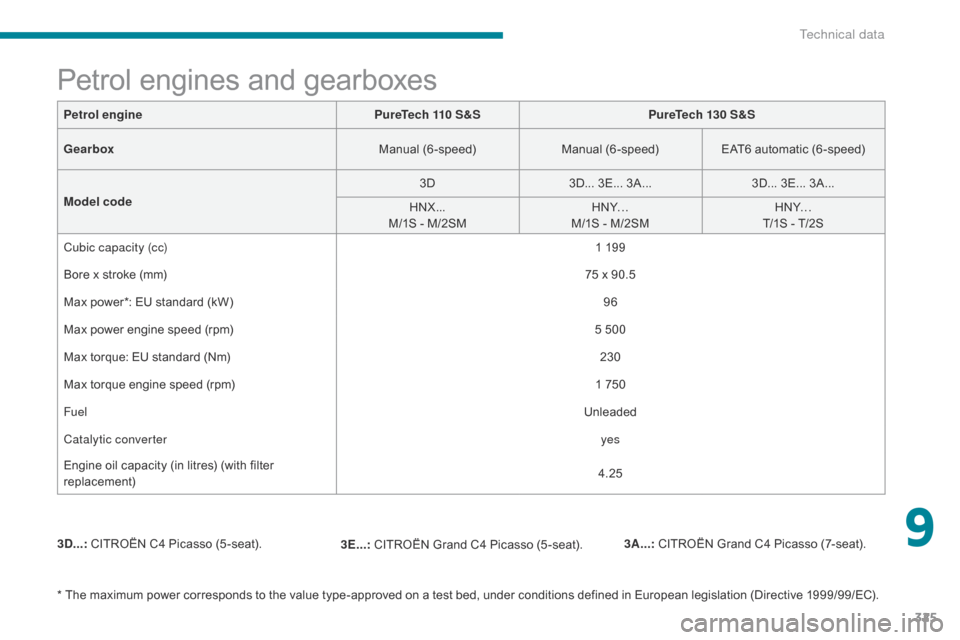
325
C4-Picasso-II_en_Chap09_caracteristiques-techniques_ed02-2016
Petrol enginePureTech 110 S&SPureTech 130 S&S
Gearbox Manual (6-speed)Manual (6-speed)EAT6 automatic (6 -speed)
Model code 3D
3D... 3E... 3A... 3D... 3E... 3A...
HNX...
M/1S - M/2SM HNY…
M/1S - M/2SM HNY…
T/1S - T/2S
Cubic capacity (cc) 1 199
Bore x stroke (mm) 75 x 90.5
Max power*: EU standard (kW) 96
Max power engine speed (rpm) 5 500
Max torque: EU standard (Nm) 230
Max torque engine speed (rpm) 1 750
Fuel Unleaded
Catalytic converter yes
Engine oil capacity (in litres) (with filter
replacement) 4.25
Petrol engines and gearboxes
3D...:
CITROËN C4 Picasso (5 -seat). 3A...: CITROËN Grand C4 Picasso (7-seat).
3E...: CITROËN Grand C4 Picasso (5 -seat).
* The maximum power corresponds to the value type-approved on a test bed, under conditions defined in European legislation (Directive 1999/99/EC).
9
Technical data
Page 328 of 527

326
C4-Picasso-II_en_Chap09_caracteristiques-techniques_ed02-2016
3D...: CITROËN C4 Picasso (5 -seat). 3A...: CITROËN Grand C4 Picasso (7-seat).
3E...: CITROËN Grand C4 Picasso (5 -seat).
* The maximum power corresponds to the value type-approved on a test bed, under conditions defined in European legislation (Directive 1999/99/EC).
** For Israel. Petrol engine
THP 150 / 160THP 165 S&S THP 165 S&S**
Gearbox EAT6 automatic (6 -speed) EAT6 automatic (6 -speed) EAT6 automatic (6 -speed)
Model code 3D... 3E... 3A...
3D... 3E... 3A...3D... 3E... 3A...
5GX - 5GY...
A-A/1-A/2-A/D- A/1D- A/2D- Y-Y/1-Y/ 2 5G Z T/S
5GY...
A /S - A /1S - A /2S
Cubic capacity (cc) 1 5981 5981 598
Bore x stroke (mm) 77 x 85.877 x 85.877 x 85.8
Max power*: EU standard (kW) 110 / 121121121
Max power engine speed (rpm) 6 0006 0006 000
Max torque: EU standard (Nm) 240240240
Max torque engine speed (rpm) 1 4001 4001 400
Fuel UnleadedUnleadedUnleaded
Catalytic converter yesyesyes
Engine oil capacity (in litres) (with filter
replacement) 4.25
4.254.25
Technical data